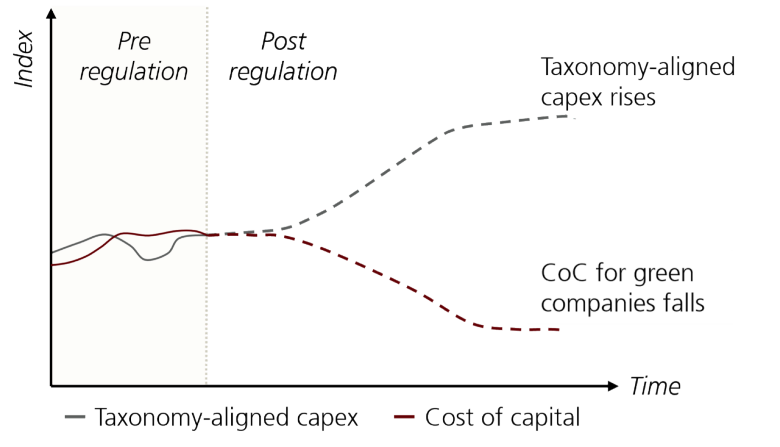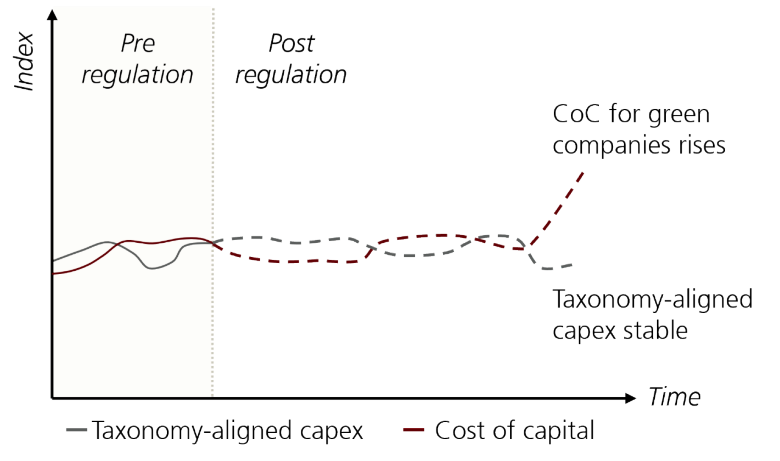We would like to thank our generous sponsors for making this article possible.
Sustainable finance regulations are booming in volume and diversity, but few people are tracking their real-world impact.
Concerned by Delhi’s booming population of venomous cobras, the British colonial rulers in the nineteenth century offered a bounty for every dead snake. It worked—at least initially. Locals eagerly presented many dead cobras to receive well-earned bounties. But creative entrepreneurs spotted an opportunity; they simply bred cobras to claim the reward. When the authorities caught on, the rewards were scrapped, and the bred cobras were released. The British were out of pocket, and there were more cobras than ever.

The ‘cobra effect’ illustrates that rushed regulations can incentivize people to act in a manner that undermines the rule’s initial aim. This is a particular concern when lots of new rules are hurriedly introduced.
Sustainable finance finds itself here today. As policymakers forge new tools to direct the firepower of financial markets at sustainability goals, green finance regulations are multiplying in volume and diversity (table 1). They share the same end—to direct capital flows in support of public goals—but through different means. While some are novel, such as green taxonomies, others reinvent old tools, such as disclosure rules.
From our partners:
| Table 1. Growing wave of sustainable finance regulations | ||
|---|---|---|
| Perceived Problems | Regulatory tool | Examples |
| No consensus definition on sutainable activities | Green taxonomies | EU taxonomy for sustainable activities |
| Limited and low-quality sutainable data | Data disclosure rules | EU Corporate Sustainability Reporting Directive (CSRD)Proposed US SEC climate disclosure rules |
| Opaque ESG methodologies | Methodology disclosure rules | Proposed UK ESG provider regulationsJapan’s voluntary ESG code of conduct |
| Greenwashing in financial industry | Financial market disclosure regime | EU Sustainable Finance Disclosure Regulation (SFDR) |
Source: UBS
These new rules will be crucial for delivering sustainability goals. But in playing devil’s advocate for a moment; the rush to implement seemingly sensible sustainable finance regulations today could generate unforeseen problems tomorrow. While uncertainty naturally surrounds them—as it does the broader low-carbon transition—few are monitoring the impact of this new generation of regulations, thus leaving important yardsticks of success unanswered.
New risks
The expansion of relatively untested sustainable finance regulations creates new risks. For instance, regulating what is and is not green—the sole task of the EU taxonomy—is fraught with difficulty1 . It is vulnerable to lobbying (as the inclusion of natural gas reflects), its goals have shifted several times (providing unclear signals to the market)2 , and its thresholds may struggle to keep pace with changing definitions of sustainability.
Another example is corporate sustainability disclosures. While well-meaning, the burden on companies could outweigh the benefits if no one utilizes the data, particularly for small organizations with shoe-string operational budgets3 . Disclosure regulations can also leave too much wiggle room between disclosure points, inadvertently disguising the status quo4 .
This is far from arguing against green financial regulations, which are crucial to achieve sustainability goals at speed and potentially lower costs. For instance, taxonomies could lower the cost of capital for green companies by helping investors identify those most exposed to low-carbon technologies—a lightning rod for capital-intensive low-carbon energy5 . But it’s crucial to ensure regulations do not incubate unintended consequences, which starts with monitoring their real-world impact.
Never a failure, always a lesson
Regulators could do more to analyze the real-world impact of sustainable finance rules. For example, while the EU has recently upped its game6 , it undertook a relatively light-touch impact assessment of its initial Sustainable Finance Action Plan, with no causal or quantitative analysis7 .
Admittedly, these analyses are difficult in noisy financial markets. Some regulations like the EU taxonomy are also new and unfolding, making empirical tests difficult without more data. More broadly, nobody knows how the transition will unfold; so it shouldn’t be surprising that it’s also difficult to invent the best tools to direct us there.
But while policymakers constantly act under uncertainty, first-of-a-kind sustainable finance regulations are particularly uncertain. Their impact on financial markets needs to be carefully monitored to avoid unintended consequences and highlight what works and what doesn’t.
Of course, regulators monitor policies all the time, but not all reviews are equal. The holy grail for sustainable finance regulations would be to review their impact through the lens of regular, ex-post empirical evaluations. As data to test their real-world impact emerges, a ‘test-learn-refine’ approach would lead to better regulation over time
What might these tests look like? Regulations tend to lack clear-cut end points, making this a question of direction rather than a pass or fail. The task for ex-post empirical assessments is then two-fold:
- Define success through identifying key metrics; and
- Test the directional impact around regulatory events to monitor how financial markets respond around the time of regulations (making observed effects more likely down to regulatory impact, an approach known as an ‘event study’8 ).
Using the EU taxonomy as an example (figure 1), ex-post assessments could first gather data on the cost of capital (which may fall for green firms) and taxonomy-aligned capex (which may rise as corporate investment aligns with the transition). Analyses could then test whether movements in these yardsticks can be linked to key regulatory events (like announcements or implementations), a technique previously used to link positive green equity price movements to the Paris Agreement9 .
Figure 1. Stylized ex-post assessment of the EU taxonomy.
The direction of success metrics provides a framework for evaluating the real-world impact of sustainable finance regulations.
Example 1: Regulations seem to work

Source: UBS
Example 2: Intended outcomes are not observed

Source: UBS
This is just one approach of many, and in an ideal world sustainable finance regulations would include similar analyses as business-as-usual. Writing reviews into legislation is easier said than done—it can be unclear who or what triggers them—but facilitative approaches exist, such as moving administrative detail to the lowest regulatory level10, or simply more principle-based regulation. Likewise, successful ‘test-learn-iterate’ examples exist today, from both outside and inside the world of sustainable finance. A good example is the Singaporean taxonomy’s ‘traffic light’ system, which adapted the EU taxonomy’s binary ‘green-or-not’ approach.
While it’s difficult to predict the future of financial markets, looking backwards is easier, and it enables policymakers to calibrate yet-untested tools. The EU is increasingly showing signs of a growing ‘test-learn-iterate’ approach to sustainable finance11, and some financial markets (like the UK) are in a privileged position to learn from first movers. Doing this well requires a robust and ideally quantitative focus on real-world impact.
1Ben Caldecott (2019), ‘Encourages laziness and disincentivizes information’: Ben Caldecott shares his thoughts on the EU’s green taxonomy, Responsible Investor.
2The EU taxonomy’s goals expanded and shifted over time, from directing capital to green activities, to preventing greenwashing, to incorporating elements of transition.
3ERM (2022), Survey reveals costs and benefits of climate-related disclosure for companies and investors.
4Parise, G. and Rubin, M. (2023), DP18270 Green window dressing, CEPR Discussion Paper No. 18270.
5See Oxford Sustainable Finance Group (2023), Energy transition risk and cost of capital.
6Although varying in robustness, more recently EU regulators have been assessing the impact of SFDR and its associated regulations through consultations and assessments as part of the implementation phase of regulation; for two recent examples of robust reviews, see European Securities and Markets Authority (ESMA) (2023), Progress report on green washing: Response to the European Commission’s request for input on “greenwashing risks and the supervision of sustainable finance policies and ESMA (2022), TRV Risk Analysis: EU Ecolabel: Calibrating green criteria for retail funds.
7Cooke, D. et al (2021), Are sustainable finance policies evidence-based? An analysis of whether the EU’s procedural framework for sustainable finance policy making is fit for purpose, 2i Investing Initiative.
8Event studies are usually more complicated than the stylized example in Figure 1, involving forecasting of a ‘BAU’ scenario without regulation (typically using CAPM for financial market studies), statistical tests of significance, and checks for wider confounding factors.
9Kruse, T., Mohnen, M., and Sato, M. (2023), Do financial markets respond to green opportunities?, Journal of the Association of Environmental and Resource Economists.
10Pushing administrative detail into the lowest level of regulation possible makes it easier to adjust in the future based on circumstances, compared to things baked into Level 1 legal text.
11see footnote 8.
The author is grateful for feedback from: Judson Berkey, Etienne Buff, Gillian Dexter, Nadine Jatto, Christian Leitz, Armin Peter, Richard Morrow, Richard Mylles, Mike Ryan, Jackie Bauer.
For further information, please visit www.ubs.com/institute-disclaimer
By: William Nicolle
Originally published at: UBS












